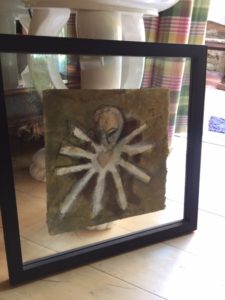 When TF picked up this work on paper at a charity auction she knew nothing about it. But she loved the octopus. She asked me to find out about the artist. The piece is signed Mireia Zantop (b. 1965, Spain), and a little research said the artist began her artistic life as a two-dimensional painter. Now she teaches body language and identity relations as a performance artist, specializing in action poetry. She follows a long tradition in Spain of multi and transdisciplinary artists who fit the brand called Spanish Modernism.
When TF picked up this work on paper at a charity auction she knew nothing about it. But she loved the octopus. She asked me to find out about the artist. The piece is signed Mireia Zantop (b. 1965, Spain), and a little research said the artist began her artistic life as a two-dimensional painter. Now she teaches body language and identity relations as a performance artist, specializing in action poetry. She follows a long tradition in Spain of multi and transdisciplinary artists who fit the brand called Spanish Modernism.
In these times of lock-down I dream of joining this artist in one of her performance pieces at La Muga Caula festival, happening in early September in Catalonia. How wonderful to trek out to the local waterfall, and hide in those caves, and soak in the thermal baths while seeing Avant Garde Spanish performance artists! The festival, termed more of an event or happening, takes place mainly in the Basque countryside. How wonderful.
La Muga Caula
This festival pays homage to the Dadaist movement, and one of its founders, Marcel Duchamp (1887-1968), a fascinating geniuses in the history of modern art. The festival of action poetry marks Duchamp’s visit to the waterfall and to the village of Les Escaules in 1965. A performance piece takes place at the site of a photo taken of him at the “salt de la Caula,” a waterfall gorge home to Paleolithic remains, and evidence of habitation for 600,000 years.
I love my job because I get to imagine how other artists take ideas from other artists, and why. In this case TF’s artist, Mireia Zantop, took the spirit of the Dadaist movement into her work as a performance artist. The Dadaist philosophy says art is not anything, and art is everything, all at once. To prove this they took everyday objects and ‘made’ them into art by their significant settings, framings, unveilings, and shadows. This movement emerged at the beginning of the 20th century with the world reeling from WWI and its aftermath.
The Dadaist Movement
So the movement of irreverent art, a slap in the face to the art world that came before, which realistically represented objects, made lasting impact. One of Marcel Duchamp’s paintings celebrated at this performance festival of La Muga Caula is Tu m’. An interesting title short for the French slang for two phrases: tu m’emmerdes (you annoy me) or tu m’ennuies (you bore me).
In 1918 Duchamp created Tu m’ in a a strange size (27″ x 119”), more of a mural meant to hang over a long bookcase in the home of Katherine Dreier. Like most Dadaist paintings, this series of ‘ready-mades,” incorporates everyday things, but set into a work of art to BECOME art: a bike wheel, a corkscrew, and a hat rack in Trompe l’oeil. Duchamp painted these three elements realistically – with their shadows in place to create the sense of three dimensions. This painting also includes REAL objects: a bottle brush, a bolt, and safety pins.
Why does Mireia Zantop celebrate DADA style art?
The Dadaist movement questioned the way we think about art. That art is not a thing, but an experience of how we perceive something, exactly what true performance art represents. Performance artists, like Mireia Zantop, use a performance to suggest reality, like Duchamp’s painting, Tu m’. A performance is both an imitation, and an actual event. La Muga Caula also rejoices in another old photo, which draws a circle around the still flourishing Dadaists. A picture taken by Man Ray shows Duchamp in 1968 upon his birthday. Duchamp has no head in the photo, but he holds his birthday cake between his legs. This exemplifies the irreverent spirit of the movement.
To sit at my dining room table, now my office, I can only dream of attending an event meant to reach all the senses at a Catalonian waterfall. So, TF, you see the power of art once you understand its spirit. Thank you for sending me on this trip!